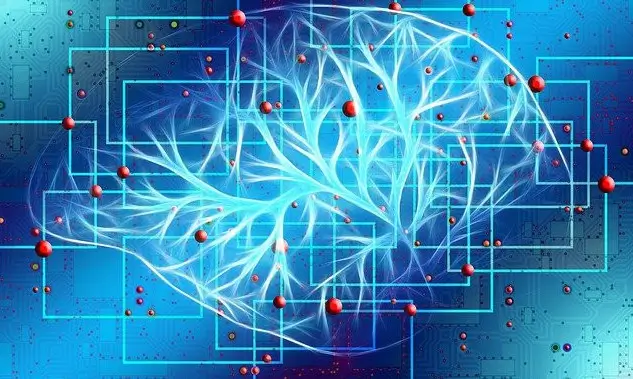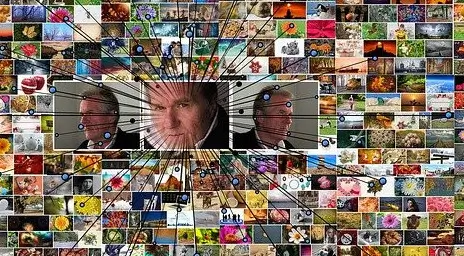Artificial Intelligence is a branch of computer science that studies intelligent agents. An intelligent agent is any device that maximizes the probability of achieving its goals by understanding the world around it. A definition of Artificial Intelligence is: AL is the ability of a system to interpret external data; this system learns by applying data and applies what it has learned to achieve specific goals.
Artificial Intelligence includes two different words:
Artificial means man-made, and Intelligence means the mind to understand principles ability, truths, or meanings, to acquire knowledge, and to turn science into action based on the learn and understandability.
Thus, Artificial Intelligence is a machine created by humans to make life easier and more comfortable, in the form of computer programs or machines that aid in thinking and learning. Of course, in general, any object around us and can leave feedback can indicate the presence of artificial intelligence within itself (even in the simplest cases, such as a cookie clock.)
These intelligent machines must think and act like humans, so much so that according to the Turing test, if a smart machine and a human talk to each other, the human will not realize that the other side is a robot.
History:
The concept of artificial intelligence dates back to ancient times, and its myth logically related to the creatures have the consciousness and intelligence given to those creatures by the creator to try to reach the final goal, which is the forgery of the gods.
In the new age, philosophers first sought to simulate the process of human thinking. With the invention of programmable digital computers based on mathematical concepts in the 1940s, the idea became very popular, and scientists discussed building an electronic brain. Due to the exciting nature of the subject, it received a great deal of attention from the mid-1950s to the 1980s and was invested in by many countries heavily (including the United States, Britain, and then Japan), which failed miserably. Artificial Intelligence needed time and hardware development that did not exist at the time and did not reach investors’ goals. However, this issue receives a lot of attention since the beginning of the second decade of the twentieth century and playing its role in many life places. “We see only a short distance ahead of us, but it needs to do a lot of work,” says Alan Turing in one of his old articles.
Classification of artificial intelligence systems:

The first type of category:
A classification based on the intrinsic properties of the types of artificial intelligence proposed by Arendt Hintz (Michigan State University professor), it divides into the following four types:
Reactive machine:
This type of learning does not use memory or precisely experience and tries to explore all possible options at any time and come up with the best solution. A prime example of this was IBM’s Deep Blue chess intelligence, which in 1997 defeated Gary Kasparov (chess champion of the decade). Such machines cannot learn over time and experience receiving different inputs and only operate on a predetermined basis (like a student who only memorizes).
The limited memory machine:
Unlike the previous type, this system uses previous information for its selections. This type of artificial intelligence has been seen in self-driving cars in the last decade. This area is more about reinforcement learning, which I will explain more about later. Examples include new types of chess games, multiplayer games, and so on.
Theory of Mind:
It is a branch of artificial intelligence that has not yet been implemented and considers a person’s psychology along with a person’s beliefs, aspirations, and intentions. This artificial intelligence follows the human interaction based on the said characteristics. This type of artificial intelligence has not yet become a reality despite dramatic advances.
Self-Awareness Intelligence:
Artificial intelligence brings consciousness, extraordinary intelligence, self-awareness and emotion, and ultimately a perfect human being. Of course, such systems do not yet exist externally, and their implementation is a turning point and the final destination in the field of artificial intelligence.
The second type of category:

This classification based on the capabilities of this field and its technological part divide into the following three categories:
Weak AI:
Weak artificial intelligence (also known as narrow or narrow) is a type of artificial intelligence that focuses on a specific problem and seeks to solve it. Most AI services around us are of this type. For example:
Internet taxi systems, car cars, personal assistants such as Alexa, intelligent email identification services, stock forecasting systems, weather forecasting, etc
Each of the specific models uses artificial intelligence with different algorithms that lose their efficiency as the type of problem changes. Therefore, this type of artificial intelligence does not have the necessary comprehensiveness.
General AI:
General (or strong) artificial intelligence is a type of artificial intelligence. It has the necessary comprehensiveness and generality, unlike weak artificial intelligence. It can simulate human behavior in different situations and think, understand and behave exactly like a human being. This type of artificial intelligence, like humans, unlike weak artificial intelligence, has awareness and emotion. Computers are now faster at analysis than humans. Computer systems, like humans, don’t have capabilities such as creativity, conscience, and the ability to think abstractly. These are features that are very difficult to embed in computers and put humans in a higher position than computers. Humans are decades away from bringing computers to this frightening stage (maybe artificial intelligence can do justice or beat everyone ..!). We will not have a distance to reach the highly-intelligent artificial intelligence (Superintelligent AI) after reaching this stage.
Superintelligent AI:
We have reached the most exciting part of this text! To explain this part, suffice you see the movie I am a Robot or his movie (HER). At this stage, computers will be superior to humans in every way. They can be robots much more powerful, much faster, much smarter, and much more creative than humans.
Systems that help humans in various fields are also a simple type of Superintelligent AI. For example, smart glasses, specialized assistants in the military and medical fields are simple Superintelligent AI applications. But the more advanced version, which Ilan Musk may be pursuing in the Neuralink project, is at least helping people with amputations to make artificial limbs and connect to the brain or prevent Alzheimer’s, but it could be an introduction to the composition of the human brain with artificial intelligence!
Applications of artificial intelligence:

The applications of artificial intelligence are endless. Artificial intelligence is evolving in all areas from politics to agriculture and entertainment. AI use in medicine and health, transportation, astronautics, entertainment and games, finance and business, social media, robotics, agriculture, education. Of course, this list is much longer and will get longer over time. Here are some applications of artificial intelligence in different industries.
Computer field:
You may think that artificial intelligence is a very complex subject that has no place in your daily life. But every time you search on Google or store sites like Amazon suggest you buy a new product, they are using artificial intelligence. These sites give you the best offer based on your previous searches, your time and place, and many other factors.
Another application of artificial intelligence in computer science is the data analysis integration with quantum computers, which increases the data analysis speed. This pair will cause many changes in the future of all fields and industries because, in the 21st century, data is the fuel of technologies and industries.
Medical field:
Artificial intelligence uses in many areas of health and medicine. Some of the applications of artificial intelligence in medicine are as follows;
- Data mining to find the pattern (Pattern) of medical tests to diagnose diseases
- Surgery by a robot
- Making medicine
online sale:
Online sales sites are one of the first businesses to make money from artificial intelligence. Offers from sites like Amazon use sophisticated artificial intelligence and deep learning algorithms based on your past purchasing pattern, location, time, and other factors. Chatbots used on sites to communicate with users also use artificial intelligence to respond to their customers.
Agriculture industry:
One of the applications of artificial intelligence in the agricultural industry is the use of quadcopters and satellite imagery to control crops, water, fertilizers, pests, and weeds in agriculture and orchards. Artificial intelligence algorithms can report problems by evaluating and analyzing farmland images and help increase farmland productivity to reduce water and fertilizer use and increase crop production.
Applications of artificial intelligence in everyday life:

Face recognition by mobile phone:
One of the first things many people do every day is use smartphones. When your mobile phone is locked using biometrics such as face ID, an artificial intelligence function is used to activate it.
Social Networks:
Today, the social media market has become popular due to the use of artificial intelligence and social media in people’s lives.
Email or message:
We deal with tens or hundreds of emails and messages every day. Write error-free e-mails using artificial intelligence tools that can also process natural language (NLP).
Google Search:
Most of us have a laid-back attitude when it comes to painting a picture about ourselves. Search engines can’t scan the entire Internet to get what you need. This is where the role of artificial intelligence comes into play.
Smart home appliances:
Smart home appliances are becoming more and more popular. Many heating and cooling devices are now equipped with an intelligent thermostat system that adjusts to our daily habits and regulates the temperature according to the wishes of the residents before they return home.
Travel to and from work:
Travel aids, which are made possible by artificial intelligence, include more maps and routes. You can also use city traffic maps for a convenient schedule to get to work or travel within the city.
Banking systems:
There are several ways to deploy artificial intelligence in our banking system. Banks are always involved in security issues and detecting counterfeit banknotes. Now you can pass your check using your mobile phone or even log in to your bank account online. Also, when buying from a shop and using a bank card, artificial intelligence can determine whether the use of this card is allowed or not and whether the transaction is valid or not.
Familiarity with the most important terms in the field of artificial intelligence:

Artificial intelligence:
Artificial intelligence means that machines think and act like humans. Machine learning and deep learning are subsets of artificial intelligence. In fact, through machine learning and deep learning algorithms, artificial intelligence is used in various fields.
Machine learning:
Machine learning is a subset of artificial intelligence that includes algorithms that enable the machine to learn and operate without human intervention using the examples given to it and its own experiences.
Deep learning:
Deep learning is an evolved version of machine learning and a subset of it. In deep learning using artificial neural networks. The difference between deep learning and machine learning is that machine learning must give data to the algorithm categorically, but in deep learning, the algorithm can analyze and classify data. For example, in machine learning, to identify a dog photo, all the components of the dog, such as head, body, tail, etc., must be defined separately for the car, but in deep learning, the machine can identify other dog photos by seeing a large number of dog photos. That’s why deep learning requires a lot of big data.
Artificial neural networks (ANNs):
Artificial neural networks inspired by the neural networks of the human brain, although not very similar in function. As mentioned, artificial neural networks use in deep learning. A neural network has hundreds, thousands, or even millions of artificial neurons called units located in a set of layers. The artificial neural network consists of an input layer, an output layer, and layers between the two called hidden layers.
Natural language processing (NLP):
Natural language processing is a subset of artificial intelligence for understanding human language by computer. Natural language processing uses by a computer to read and understand human language to bridge the gap between human speech and computer comprehension.
Big data:
Big data is a large amount of data generated very quickly, is highly varied and complex, and is very difficult and time-consuming to process using traditional methods. In the importance of big data, it is enough to refer to data as 21st-century oil, and the success of companies depends on the large volume of their data.
Conclusion:
In this article, we tried to introduce artificial intelligence and its types of categories. Artificial intelligence uses in most everyday issues to improve the human growth process and make life easier. Various issues, including possible future concerns, cannot be an obstacle to its development at the moment, and with the advancement of software and hardware, the use of artificial intelligence is increasing.



